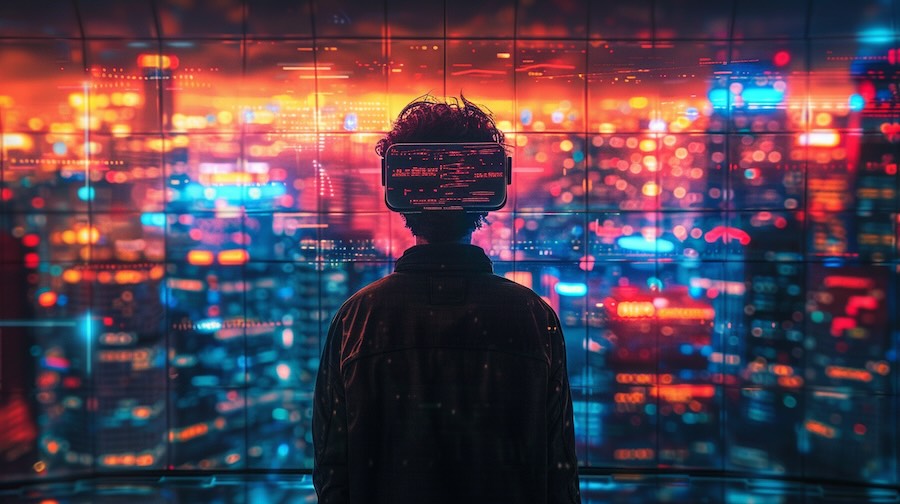We created this blog post for the EU-funded project “V2B: Creating NFT Opportunities on Metaverse for Art VET Trainees”, and our project reference number is 2022-1-DE02-KA210-VET-000080828. Coordinated by L4Y Learning for Youth GmbH in collaboration with Adana Cukurova Guzel Sanatlar and EMC Services Ltd, “Mapping the Metaverse: Key Locations and Features” is prepared related to the training framework in the introduction post.
The Metaverse, a term that has recently gained significant traction, is defined as a digital realm. In this realm, users can immerse themselves in three-dimensional environments and interact with one another. This module begins a journey to uncover the Metaverse’s critical locations and features, emphasizing the importance of understanding its Metaverse Key Features.. It provides a comprehensive view of the various platforms, mechanisms, and technologies that are shaping its development. We focus on both the current landscape and the exciting potential that the future holds. This approach ensures that learners are well-equipped to comprehend the Metaverse’s emerging role across various industries. Thoughtfully designed, this module caters to individuals with a curiosity for the Metaverse concept. It is particularly appealing to inventors, entrepreneurs, and investors alike.
The post is created for learners who are interested in emerging technologies, digital inventions, and the future of online relations. You can also find more blog posts in our R2 category. It is one of the posts.
Metaverse Key Features: Learning Objectives
- Define the concept of the Metaverse and explain how it relates to virtual reality and blockchain technologies
- Compare and differ different Metaverse platforms, technologies, and operations
- Estimate the implicit operation of the Metaverse in diligence, including gaming, entertainment, and education
- Assess the challenges and openings presented by the growth of the Metaverse for inventors, entrepreneurs, and investors
Preface to the Metaverse
This opening chapter introduces the fascinating realm of the Metaverse. It’s a conceptual virtual world where users traverse three-dimensional landscapes and engage with digital surroundings. As learners embark on this journey, they gain comprehensive insights. These insights delve into the essence of the Metaverse, exploring its historical foundations. Additionally, we discuss the profound role of virtual reality and blockchain technologies. These technologies are crucial in shaping the Metaverse’s contours.
The Metaverse, at its core, is a digital rendition of reality, striving to replicate its every facet, ranging from the intricacies of identity and social interactions to its profound implications in the realms of business and entertainment. It emerges as a parallel universe, a digital mirror that is progressively catalysing transformation across various sectors. This transformation is not an abstract notion; it materializes in tangible ways. For example, it empowers individuals to work remotely, subsequently birthing entirely new professions, including but not limited to the likes of 3D digital designers, metaverse coders, and NFT artists. The implications are vast, rippling into domains as diverse as employment, creativity, and personal lifestyle choices.
The Metaverse’s Impact on Society and Entertainment
In particular, the entertainment industry is poised for a seismic shift, where the Metaverse promises to redefine how people consume and engage with events. Notably, music festivals serve as a compelling example of the Metaverse’s impact. Moreover, they may transcend their physical limitations, hosting a limitless number of participants with significantly diminished safety concerns. Consequently, this unparalleled scale and accessibility open doors to immersive, shared experiences of unprecedented magnitude. Furthermore, music festivals in the Metaverse symbolize the blend of digital and real-life experiences, thereby creating transformative possibilities.
As learners delve deeper into the Preface of the Metaverse, they will find themselves standing at the threshold of an exciting and evolving landscape. This realm extends far beyond mere technology. Moreover, the Metaverse unfolds as a convergence of the physical and digital worlds, offering a domain brimming with immense potential and opportunities for societal reconfiguration. Consequently, it beckons individuals to explore, adapt, and harness its transformative power. Thus, creating a dynamic and thrilling experience that transcends virtual boundaries.
Metaverse Key Features: Current State of Metaverse Platforms and Applications
This chapter explores the current state of Metaverse platforms and operations, including their crucial features and limitations. Units covered in this chapter include several elements. First, we explore popular Metaverse platforms. Next, we examine how these platforms enable stronger relations. We also delve into the role of blockchain in Metaverse platforms. Additionally, we compare Metaverse platforms with virtual reality platforms. The current state of the Metaverse is characterized by diversity. This diversity is evident in the landscape of existing platforms. These platforms vary in size, focus, and capabilities.
Overview of Metaverse Platforms
- AltspaceVR: Acquired in 2017 by Microsoft, the virtual platform enables the creation of virtual events and is part of the tech giant’s Mixed Reality division. Users can host a meetup, a show, or a class.
- BlueJeans: Meanwhile, BlueJeans emerges as a video platform tailored for flexible work in enterprise and mid-sized businesses. Significantly, in 2021, the company embarked on a partnership with MootUp to revolutionize “virtual events in the era of the metaverse” by introducing 3D, VR, and AR immersive environments, along with avatars and AI chatbots, thereby enhancing user engagement.
- Cryptovoxels: Furthermore, Cryptovoxels offers a unique blend of virtual world gaming powered by cryptocurrency and the Ethereum blockchain, featuring real-life infrastructures such as roads and buildings. This platform invites users to immerse themselves in a blockchain-based environment, merging gaming with digital asset ownership.
- Gather: Lastly, Gather focuses on a video chat experience that overlays a virtual layer onto the physical world, catering specifically to enterprise needs. It replicates an office setting and integrates deeply with video conferencing, according to Gownder. This approach provides a seamless blend of virtual and physical office dynamics, facilitating remote collaboration.
Diverse Metaverse Environments
- Metahero: is a universe where anyone can be a hero. The platform offers six different kits with avatars that can be customized and personalized.
- Meta Horizon Worlds and Horizon Workrooms: Meta (formerly Facebook) bills its fledgling metaverse Horizon platform as an “ever-expanding social universe” to hang with friends and create your own worlds. Workrooms is the company’s mixed reality app for employee collaboration.
- Nvidia Omniverse: The chipmaker’s virtual platform focuses on 3D design work on computer graphics, simulations and the creation of new worlds.
- Roblox: e a platform that empowers people to come together, play, to explore, learn and connect with one another.
- Rooom: specializes in enterprise virtual showrooms, 3D product presentations and virtual events that can be used by marketing and sales groups in verticals such as education, retail, life sciences and manufacturing.
- Sandbox: is a community-driven gaming platform built on the Ethereum blockchain.
- Second Life: On the other hand, Second Life’s Metaverse City bills itself as “a welcoming role-play community” with immersive experiences that let players come in and out as they like.
- Somnium Space: Users can purchase digital land parcels and build homes and buildings, as well as start businesses, among other activities.
Challenges in the Metaverse Ecosystem
While the metaverse holds tremendous promise, it’s not without its set of challenges that we must tackle:
Technology Hurdles: Currently, technology, including graphics, networks, and devices, presents significant limitations. Advancements in these areas are crucial for creating a seamless and immersive metaverse experience.
Ecosystem Complexity: The technical infrastructure supporting the metaverse is still in its early stages. We’re working on establishing standardized protocols to make integration and interaction within the metaverse smoother and more efficient.
Accessibility and User-Friendliness: Despite our familiarity with digital tools, stepping into the metaverse can feel like entering a whole new world. Many platforms cater primarily to gamers, which can be intimidating for those less experienced in gaming or technology.
As the metaverse continues to evolve, addressing these challenges becomes crucial to ensure its development into a more inclusive and user-friendly virtual space. In doing so, it welcomes everyone to enjoy its wonders, transforming it into a realm where all users can explore and thrive without barriers.
Metaverse Key Features: Metaverse Technologies
This chapter delves into various Metaverse platforms, technologies, and operations, providing a comprehensive overview. The units include an in-depth exploration of decentralization and Non-Fungible Tokens (NFTs) within the Metaverse, examining their influence on crucial aspects such as ownership and authenticity. By doing so, it aims to shed light on how these technologies reshape the dynamics of power and authenticity in the virtual world.
The main 7 key technologies that are powering the metaverse:
Foundational Technologies of the Metaverse
- Blockchain: blockchain technology as the sturdy foundation of the metaverse. It’s like the glue holding everything together. Developers use it for various functions within the metaverse, such as verifying digital ownership, transferring value, managing rules, collecting digital treasures, ensuring accessibility, and making different pieces work together seamlessly.
- Crypto Currency: In the metaverse, cryptocurrencies rule the roost. It’s like the currency of this virtual realm. To do anything in the metaverse, you first have to swap your real-world cash for crypto. It’s the key to buying things like unique digital items (NFTs), virtual land, or even in-game goodies.
Immersive Experiences: AR, VR, and AI in the Metaverse
- AR & VR Magic: Augmented Reality (AR) and Virtual Reality (VR) tech play a starring role in making the metaverse an unforgettable virtual adventure. They work like magic, crafting immersive 3D worlds that you can step right into.
- Artificial Intelligence: Think of Artificial Intelligence (AI) as the wizard behind the curtain in the metaverse. It’s there to make everything feel real and immersive. AI takes care of all the behind-the-scenes work, making the metaverse come alive.
Enhancing Connectivity and Realism: IoT, 3D Reconstruction, and Edge Computing in the Metaverse
- 3D Reconstruction: During the COVID-19 pandemic, 3D Reconstruction tech became the hero. It helped folks explore places and properties virtually when they couldn’t visit them in person. Companies used it to create virtual property tours and showroom experiences.
- Internet of Things (IoT): Imagine IoT as the ultimate connector of the physical world to the internet. It’s like giving everything around us a voice and the ability to share information automatically. This can be witnessed in devices such as voice-activated speakers, smart thermostats, and medical gadgets, which not only process data but also take actions autonomously.
- Edge Computing & 5G: Edge computing is like the speedster of the metaverse. It ensures data travels quickly with minimal delays, making for smoother experiences. It’s a key ingredient in making sure the metaverse runs seamlessly, especially when things get intense during gaming, so you can enjoy a lag-free, immersive adventure.
Challenges and Opportunities of Metaverse for Developers, Entrepreneurs, and Investors
This chapter presents the openings and challenges by the growth of Metaverse for inventors, entrepreneurs, and investors. Additionally, the chapter will dissect the business eventuality for those involved in designing and developing Metaverse, alongside the specialized and organizational challenges.
Challenges to the Metaverse
While investments have poured into the metaverse with an increase in the number of active users, the metaverse itself is in the nascent and developing stage.
- Security is one of the primary issues that have cropped up with an increase in the value of crypto transactions and the increase in crypto scams and malicious softwares. If meteverse is a serious project that is here to stay, it needs to improve its security standards to give users the confidence that their identity and assets are safe and secure.
- Privacy is another issue which has haunted the metaverse. Considering the fact that the metaverse uses devices such as webcams and AR & VR technology, it makes the privacy of the user susceptible to being compromised. It is a known fact that hackers have in the past hacked and exploited such devices to spy on people. So, for the metaverse to be used by the masses, such risks to privacy must be addressed and solutions be addressed.
Opportunities to the Metaverse
While the metaverse may seem like uncharted territory, it’s already teeming with exciting possibilities for businesses to tap into and connect with their customers. There’s a rich tapestry of business prospects within the metaverse, spanning various realms:
Virtual Commerce and Retail:
In the metaverse, businesses have the chance to bring their products and services into the virtual realm, opening up new avenues for sales and engagement. Additionally, this expands their reach beyond traditional boundaries.
Remote Working:
Many of us now find it hard to imagine returning to the traditional office grind. Remote work has its perks, but maintaining connections with colleagues remains crucial, not just for communication but also for overall productivity.
Virtual Real Estate:
Virtual real estate holds a special allure within the metaverse. Not only does it offer businesses opportunities to harness its potential for advertising, but it also provides avenues for hosting events, creating virtual workplaces, training environments, and even residential areas.
Virtual Events and Activities: The metaverse is a versatile stage for hosting a plethora of events, from conferences and product launches to parties and art exhibitions. It’s a hub for gatherings of all kinds.
Virtual Training and Education: The metaverse provides a platform for effective virtual training and education, particularly in industries like construction, manufacturing, aviation, and healthcare. Learners can acquire professional skills, engage with peers and teachers, and explore virtual libraries and historical sites.
Virtual Tourism and Exploration: Traveling has always been a source of inspiration, but not everyone has the means or opportunity to embark on physical journeys. The metaverse offers a virtual alternative for exploration and enrichment.
Virtual Social Platforms: As we increasingly embrace virtual worlds alongside the real one, the rise of virtual social platforms is unmistakable. These platforms facilitate socialization and communication in innovative ways.
Metaverse Gaming: Additionally, one of the metaverse’s flagship opportunities lies in creating metaverse-based games. Businesses can craft interactive virtual worlds where players become avatars, customize their surroundings, and participate in tournaments, earning rewards for their active engagement.
These metaverse business opportunities offer organizations a host of benefits. Not only do they provide advanced marketing strategies, but they also enhance cooperation and communication. Furthermore, they open new revenue streams, expand market reach, and foster greater engagement with employees and customers alike.
Mapping the Metaverse: Key Locations and Features: Conclusion
Throughout this module, we’ve ventured into a realm where the lines between reality and the virtual world blur, unleashing a realm of limitless possibilities. The metaverse, defined by its immersive three-dimensional environments and key features, is reshaping industries and revolutionizing our approach to work, connectivity, and entertainment. Moreover, in the Preface to the Metaverse Key Features, we saw how this digital parallel universe has had a huge effect on many areas, from changing the way people work from home to creating new jobs like metaverse coders and NFT artists. It holds the potential to revolutionize entertainment, offering unrestricted participation in events while ensuring safety.
Our exploration of the metaverse platforms and applications introduced us to a diverse array of platforms, each with unique features and capabilities. However, we also acknowledged the technological challenges that must be overcome for a seamless and inclusive metaverse experience. The potent technologies underpinning the metaverse include blockchain, AR/VR, AI, and IoT. Furthermore, these technologies form the bedrock of the metaverse, serving as the glue that binds this virtual world together. In Chapter 4, we delved into the opportunities and challenges the Metaverse Key Features presents for developers, entrepreneurs, and investors. While security and privacy concerns persist, the metaverse offers a rich tapestry of business prospects, spanning virtual commerce, remote work, virtual real estate, education, and more.
As we look ahead, the metaverse promises to be a transformative force, a realm where innovation knows no bounds. It beckons us to explore, create, and connect in ways we once thought impossible. With each hurdle we surmount, we draw closer to transforming this digital frontier into an inclusive and user-friendly space for all. Moreover, the Metaverse isn’t just a concept; it’s a journey into the future, and we are its pioneers.
References and Resources
- Castronova, E. (2005). Synthetic Worlds: The Business and Culture of Online Games. Chicago: University of Chicago Press.
- Chen, Z. (2018). Understanding the Blockchain Metaverse: The Implications of Decentralized
- Virtual Worlds. Journal of Economic Perspectives, 32(4), 197-215.
- Koo, Y., & Lee, J.-H. (2018). Why People Participate in Virtual Reality Social Events: The Role of Social Presence and Affective Needs. In Proceedings of the 2018 International Conference on Information Systems: Transforming Society with Digital Innovation.
- Lanier, J. (2010). You are not a gadget: A manifesto. Random House Digital, Inc.
- Rolland, C., & Ndjiki-Nya, P. (2020). Blockchain or the Metaverse: What Path to Choose?
- IEEE Computer Graphics and Applications, 40(1), 119-126.
- Zhao, J., & Lai, S. (2019). Blockchain and the Decentralization of Trust. MIT Sloan Management Review, 60(4), 12-15.
- Genady Chybranov,The Current State of the Metaverse and its Limitations, Softserve, JUL 12, 2023, https://www.softserveinc.com/en-us/blog/the-current-state-of-the-metaverse
- Kira Belova, Top 8 Metaverse Business Opportunities to Explore in 2023 and Beyond, pixelplex, 31 July, 2023, https://pixelplex.io/blog/best-metaverse-business-opportunities/










